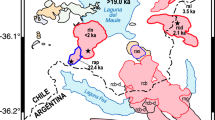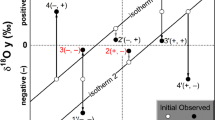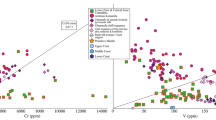Abstract—
The melting relations in the olivine–jadeite–diopside–garnet–(С–О–H fluid) system, including metasomatic СО2 carbonatization of silicates and Н2О dissolution in silicate–carbonate melts, were studied in a physicochemical experiment at 6 GPa (under the conditions of the upper mantle). The influence of the С–O–H fluid (5.0 wt %, with equimolecular contents of Н2О and СО2) on the composition and temperature of the quasi-invariant peritectic reaction between olivine and jadeite-bearing melt with the formation of garnet was demonstrated. This reaction is the key element of the liquidus structure of silicate–fluid magmatic and silicate–carbonate–carbon–fluid diamond-forming systems. This is because this reaction controls the final episodes of the fractional ultramafic–mafic evolution of magmatic and diamond-forming melts in the upper mantle. The mode of fractional crystallization contributes to an increase in the concentration of jadeite and hydrous fluid components in the residual silicate–fluid and silicate–carbonate–fluid melts, which controls the sequential change in the total composition of these systems. The importance of the jadeite component in the bulk composition of the multicomponent magmatic system changes with its fractional accumulation from a minor component in ultramafic peridotite to a major (system-forming) component in mafic eclogite. According to the experimental data, the peritectic reaction of olivine retains its primary importance, since the C–O–H fluid components do not introduce radical qualitative changes in the melting relations of the ultramafic–mafic system olivine–jadeite–diopside–garnet–(C–O–H-fluid) at 6 GPa. At the same time, their participation in the composition of the system leads to quantitative topological changes in the parameters of its liquidus structure: a decrease in the temperatures of the solidus and liquidus boundaries by 120 and ~60–80°C, respectively, as well as a shift in the composition of the peritectic reaction of olivine with an increase in the concentration of olivine-bearing component by ~10 wt %. The significance of the peritectic reaction of olivine is discussed in the context of the general scenario of the ultramafic–mafic evolution of upper-mantle magmatism and the genesis of diamond, taking into account the role of the peritectic reaction of orthopyroxene at its early ultramafic stages.















Similar content being viewed by others
REFERENCES
L. Y. Aranovich and R. C. Newton, “Experimental determination of CO2–H2O activity–composition relations at 600–1000°C and 6–14 kbar by reversed decarbonation and dehydrotation rections,” Am. Mineral. 84, 1317–1332 (1999).
T. Aulbach, T. Stachel, L. M. Heaman, and J. A. Garison, “Microxenoliths from the Slave Craton: archives of diamond formation along fluid conducts,” Lithos 126, 419–434 (2011).
R. L. Bates and J. A. Jackson, Dictionary of Geological Terms, Third edition (Ancor Books, Doubleday, New York, 1983).
P. M. Bell and B. T. C. Davis, “Melting relations in the system jadeite– diopside at 30 and 40 kb,” Am. J. Sci. A–267, 17–32 (1969).
A. P. Bobrievich, M. N. Bondarenko, L. M. Gnevushev, L. M. Krasov, G. I, Smirnov, and R. K. Yurkevich, Diamond Deposits of Yakutia (Geogeoltekhizdat, Moscow, 1959) [in Russian].
A. P. Bobrievich, G. I. Smirnov, and V. S. Sobolev, “On the mineralogy of grossular–pyroxene–disthene (grospydite) xenoliths from Yakutian kimberlites,” Geol. Geofiz., No. 3, 18–24 (1960).
B. T. C. Davis, “The system diopside–forsterite–pyrope at 40 kilobars,” In: Carnegie Institution Washington Yearbook. 63, 165–171 (1964).
B. T. C. Davis and J. F. Shairer, “Melting relations in the diopside–forsterite–pyrope at 40 kilobars and one atmosphere,” In: Carnegie Institution Washington Yearbook 64, 123–136 (1965).
J. B. Dawson, “Recent researches on kimberlite and diamond geology,” Econ. Geol. 63, 504–511 (1968).
J. B. Dawson, Kimberlites and their Xenoliths (Springer–Verlag, Berlin, 1980).
D. E. Ellis and P. J. Wyllie, “A model of phase relations in the system MgO–SiO2–H2O–CO2 and prediction of the compositions of liquids coexisting with forsterite and enstatite. In: Kimberlites, Diatremes, and Diamonds: Their Geology, Petrology, and Geochemistry, Ed by F. R. Boyd and H. O. A. Meyer, (Amer. Geophys. Union, Washington, 1979), pp. 313–318.
T. Gasparik and Yu. A. Litvin, “Stability of Na2Mg2Si2O7 and melting relations on the forsterite–jadeite join at pressures up to 22 GPa,” Eur. J. Mineral. 9, 311–326 (1997).
D. H. Green, T. J. Falloon, and W. R. Taylor, “Mantle-derived magmas – role of variable source peridotite and variable C–H–O fluid compositions,” In: Magmatic Processes: Physicochemical Principles. A volume in Honor of Hatten S. Yoder, Jr., Ed. by B. O. Mysen, (University Park, Pennsylvania, 1987), pp. 139–154.
A. J. Irving and P. J. Wyllie, “Subsolidus and melting relations for calcite, magnesite and the join CaCO3–MgCO3 to 36 kb,” Geochim. Cosmochim. Acta 39, 35–53 (1975).
E. S. Izraeli, J. H. Harris, and O. Navon, “Brine inclusions in diamonds: a new upper mantle fluid,” Earth Planet. Sci. Lett. 187, 323–332 (2001).
F. V. Kaminsky, The Earth’s Lower Mantle (Springer Geology, 2019).
H. Keppler and A. Audetat, “Fluid–mineral interaction at high pressure,” In: Mineral Behaviour at Extreme Conditions, Ed. by R. Miletich (Eotvos Univ. Press, Budapest, 2005), pp. 225–251.
D. M. Kerrick and G. K. Jacobs, “A modified Redlich–Kwong equation for H2O, CO2 and H2O–CO2 mixtures at elevated pressures and temperatures,” Am. J. Sci. 281, 735–767 (1981).
A. M. Koziol and R. C. Newton, “Experimental determination of the reaction magnesite + enstatite = forsterite + CO2 in the range 6–25 kbar and 700–1100°C,” Am. Mineral. 83, 213–219 (1998).
V. Yu. Litvin, T. Gasparik, and Yu. A. Litvin, “The system enstatite – nepheline in experiments at 6.5–13.5 GPa: importance of Na2Mg2Si2O7 for the melting of nepheline–normative mantle,” Geochem. Int. 38 (suppl. 1), 100–107 (2000).
Yu. A. Litvin, Physicochemical Study of Melting Relations of the Deep–seated Earth’s Substance (Nauka, Moscow, (1991) [in Russian].
Yu. A. Litvin, “High-pressure mineralogy of diamond genesis,” In: Advances in High-Pressure Mineralogy, Ed. by E. Ohtani, Geol. Soc. Am. Spec. Pap. 421, 83–103 (2007).
Yu. A. Litvin, Genesis of Diamonds and Associated Phases (Springer Mineralogy, 2017).
Yu. A. Litvin and V. A. Zharikov, “Experimental modeling of diamond genesis: diamond crystallization in multicomponent carbonate–silicate melts at 5–7 GPa and 1200–1570°C,” Dokl. Earth Sci. 372 (6), 867–870 (2000).
Yu. A. Litvin, A. V. Spivak, and A. V. Kuzyura, “Fundamentals of mantle carbonatite concept of diamond genesis,” Geochem. Int. 50(10), 839–857 (2016).
Yu. A. Litvin, A. V. Kuzyura, and E. V. Limanov, “The role of garnetization of olivine in the olivine–diopside–jadeite system in the ultramafic–mafic evolution of upper-mantle magmatism (experiment at 6 GPa),” Geochem. Int. 57(10), 1045–1065 (2019).
Yu. A. Litvin, A. V. Kuzyura, A. V. Bovkun, D. A. Varlamov, E. V. Limanov, and V. K. Garanin, “Genesis of diamondiferous rocks from upper–mantle xenoliths in kimberlite,” Geochem. Int. 58 (3), 245–270 (2020).
Yu. A. Litvin, A. V. Kuzyura, and A. V. Spivak, “Evolution of mantle magmatism and formation of the ultrabasic–basic rock series: importance of peritectic reactions of the rock-forming minerals,” In: Advances in Experimental and Genetic Mineralogy. Special Publication to 50th Anniversary of D.S. Korzhinskii Institute of Experimental Mineralogy, Ed. by Yu. A. Litvin and O. G. Safonov (Springer Mineralogy, 2020), pp. 165–199.
A. M. Logvinova, R. Wirth, E. N. Fedorova, and N. V. Sobolev, “Nanometre–sized mineral and fluid inclusions in cloudy Siberian diamonds: new insight on diamond formation,” Eur. J. Mineral. 20, 1223–1233 (2008).
A. M. Logvinova, L. A. Taylor, E. N. Fedorova, A. P. Eliseeva, R. Wirth, G. Howarth, V. N. Reutsky, and N. V. Sobolev, “A unique diamondiferous peridotite xenolith from the Udachnaya kimberlite pipe (Yakutia): role of subduction in diamond formation,” Russ. Geol. Geophys. 56 (1–2), 306–320 (2015).
I. D. MacGregor and J. L. Carter, “The chemistry of clinopyroxenes and garnets of eclogite and periotite xenoliths from Roberts Victor Mine, South Africa,” Phys. Earth Planet. Int., No. 3), 391–379 (1970).
A. A. Marakushev, “Peridotite nodules in kimberlites as indicators of deep lithosphere structure,” in Reports of Russian Geologists at the 27 th International Session of the International Geological Congress. Petrology (Nauka, Moscow, 1984), pp. 153–160 [in Russian].
M. Mathias and P. C. Rickwood “Ultramafic xenoliths in the Masoku kimberlite pipe,” Geol. Soc. S. Afr. Spec. Publ. 2, 359–369 (1969).
M. Mathias, I. C. Siebert, and P. C. Rickwood, “Some aspects of the mineralogy and petrology in ultramafic xenoliths in kimberlite,” Contrib. Mineral. Petrol. 26, 75–123 (1970).
O. Navon, I. D. Hutcheon, G. R. Rossman, and G. J. Wasserburg, “Mantle derived fluids in diamond micro-inclusions,” Nature 355 (6193), 784–789 (1988).
M. J. O’Hara, “The bearing of phase equilibria studies in synthetic and natural systems on the origin and evolution of basic and ultrabasic rocks,” Earth–Sci. Rev., No. 4, 69–133 (1968).
M. J. O’Hara and H. S. Yoder, “Formation and fractionation of basic magmas at high pressures,” Scott. J. Geol., No. 3, 67–117 (1967).
L. S. Palatnik and A. I. Landau, Phase Equilibria in Multicomponent Systems (Holt, Rimehart and Winston Inc., New York, 1964).
L. N. Pokhilenko, V. G. Mal’kovets, D. V. Kuz’min, and N. P. Pokhilenko, “New data on the mineralogy of megacrystalline pyrope peridotite from the Udachnaya kimberlite pipe, Siberian Craton, Yakutian Diamondiferous Province,” Dokl. Earth Sci. 454, 179–184 (2014).
M. Prinz, D. V. Manson, P. F. Hlava, and K. Keil “Inclusions in dimonds: garnet lherzolite and eclogite assemblages,” Phys. Chem. Earth, No. 9, 797–816 (1975).
A. M. Reid, R. W. Brown, J. B. Dawson, G. G. Whitfield, and J. C. Siebert, “Garnet and pyroxene compositions in some diamondiferous eclogites,” Contrib. Mineral. Petrol. 58, 203–220 (1976).
F. N. Rhines, Phase Diagrams in Metallurgy: Their Developments and Application (McGraw–Hill Book Company, London, 1956).
P. C. Rickwood and M. Mathias, “On diamondiferous eclogites xenoliths in kimberlite,” Lithos (3), 223–235 (1970).
A. E. Ringwood, Composition and Petrology of the Earth’s Mantle (McGraw–Hill, New York, 1975).
A. Saul and W. Wagner, “A fundamental equation of water covering the range from the melting line to 1273 K at pressures up to 25000 MPa,” J. Phys. Chem. 18, 1537–1564 (1989).
M. Schrauder and O. Navon, “Hydrous and carbonatitic mantle fluids in fibrous diamonds from Jwaneng, Botswana,” Geochim. Cosmochim. Acta 58, 761–771 (1994).
A. F. Shatskiy, K. D. Litasov, and Yu. N. Palyanov, “Phase relations in carbonate systems at pressures and temperatures of lithospheric mantle: review of experimental data,” Russ. Geol. Geophys. 56 (1–2), 113–142 (2015).
J. R. Smyth and C. J. Hatton, “A coesite–sanidine grospydite from the Roberts Victor kimberlite,” Earth Planet. Sci. Lett. 34, 284–290 (1977).
N. V. Sobolev, Deep-Seated Inclusions in Kimberlites and the Problem of the Upper Mantle Composition (Am. Geophys. Union, Washington, 1977).
N. V. Sobolev, E. S. Efimova, V. I. Koptil, Yu. G. Lavrentiev, and V. S. Sobolev, “Inclusions of coesite, garnet, and omphacite in Yakutian diamonds – first find of coesite,” Dokl. Akad. Nauk SSSR 230, 1442–1444 (1976).
N. V. Sobolev, A. M. Logvinova, D. A. Zedgenizov, N. P. Pokhilenko, D. V. Kuzmin, and A. V. Sobolev, “Petrogenetic significance of minor elements in olivines from diamonds and peridotite xenoliths from kimberlites of Yakutia,” Lithos 112S, 701–713 (2009).
V. S. Sobolev, B. S. Nai, N. V. Sibolev, Yu. G. Lavrentiev, and L. N. Pospelova, “Xenoliths of diamondiferous pyrope serpentinites from Aikhal pipe, Yakutia,” Dokl. Akad. Nauk SSSR 188, 1141–1143 (1969).
N. A. Solopova, A. V. Spivak, Yu. A. Litvin, and L. S. Dubrovinsky, “Melting and breakdown of MgCO3 at high pressures,” Phys. Chem. Miner. 42, 73–81 (2014).
Z. V. Spetsius, I. N. Bogush, and O. E. Kovalchuk, “FTIR mapping of diamond plates of eclogitic and peridotitic xenoliths from the Nyurbinskaya pipe (Yakutia): genetic implications,” Russ. Geol. Geophys. 56 (1–2), 344–353 (2015).
T. Stachel, G. P. Brey, and J. W. Harris, “Inclusions in sublithospheric diamonds: glimpses of deep Earth,” Elements 1, 73–78 (2005).
R. B. Symonds, W. I. Rose, G. J. S. Bluth, and T. M. Gerlach, “Volcanic gas studies: methods, results, and applications,” In: Volatiles in Magmas, Ed. by M. R. Carroll and J. R. Holloway, Mineral. Soc. Am. 30, 1–66 (1994).
S. V. Titkov, A. I. Gorshkov, Yu. P. Solodova, I. D. Ryabchikov, L. O. Magazina, A. V. Sivtsov, M. D. Gasanov, E. A. Sedova, and G. G. Samosorov, “Mineral microinclusions in cubic diamonds from the Yakutian deposits based on analytical electron microscopy data,” Dokl. Earth Sci. 410 (7), 1106–1109 (2006).
A. A. Tomilenko, A. I. Chepurov, Yu. N. Palyanov, N. P. Pokhilenko, and A. P. Shebanin, “Volatiles in upper mantle: evidence from fluid inclusion data,” Geol. Geofiz. 38 (1), 276–285 (1997).
J. V. Walther and P. M. Orville, “The extraction-quench technique for determination of the thermodynamic properties of solute complexes: application to quartz solubility in fluid mixtures,” Am. Mineral. 68, 731–741 (1983).
W. Wang, “Formation of diamonds with mineral inclusions of “mixed” eclogite and peridotite parageneses. Earth Planet Sci. Lett. 160, 831–843 (1998).
J. K. Weidner, “Equilibria in the system Fe–C–O; Part. I. Siderite–magnetite–carbon–vapor equilibrium from 500 to 10.000 bars,” Amer. J. Sci. 272, 735–751 (1972).
H. S. Yoder, Generation of Basaltic Magma (Nat. Acad. Sci., Washington, 1976).
D. A. Zedgenizov, H. Kagi, V. S. Shatsky, and N. V. Sobolev, “Carbonatitic melts in cuboid diamonds from Udachnaya kimberlte pipe (Yakutia): evidence from vibrational spectroscopy,” Mineral. Mag. 68, 61–73 (2004).
D. A. Zedgenizov, S. Rege, W. L. Griffin, H. Kagi, and V. S. Shatsky, “Composition of trapped fluids in cuboid diamonds from the Udachnaya kimberlite: LAM–ICPMS analysis,” Chem. Geol. 240, 151–162 (2007).
Funding
This study was carried out as a part of program no. AAAA-A18-118020590140-7 of the Institute of Experimental Mineralogy, Russian Academy of Sciences.
Author information
Authors and Affiliations
Corresponding author
Additional information
Translated by A. Bobrov
This paper and two following papers (Tomilenko et al. and Vinogradova et al.) complete the special issue “Geochemistry of the Earth’s mantle: experiment and nature” (n. 8, 2021).
Rights and permissions
About this article
Cite this article
Litvin, Y.A., Kuzyura, A.V. Peritectic Reaction of Olivine in the Olivine–Jadeite–Diopside–Garnet–(C–O–H) System at 6 GPa as the Key Mechanism of the Magmatic Evolution in the Upper Mantle. Geochem. Int. 59, 813–839 (2021). https://doi.org/10.1134/S0016702921080048
Received:
Revised:
Accepted:
Published:
Issue Date:
DOI: https://doi.org/10.1134/S0016702921080048




